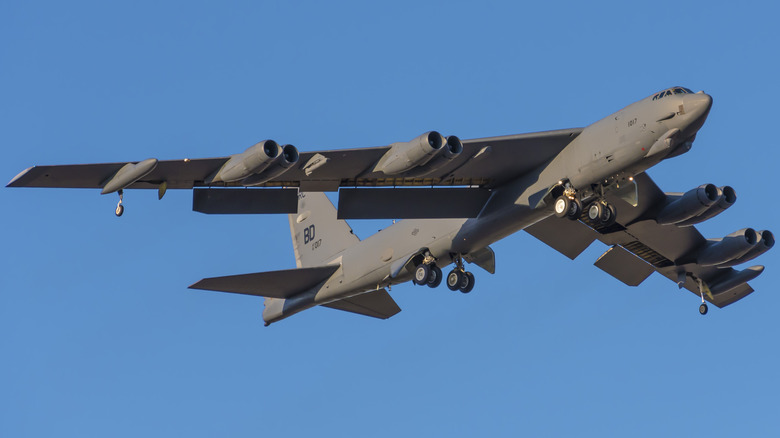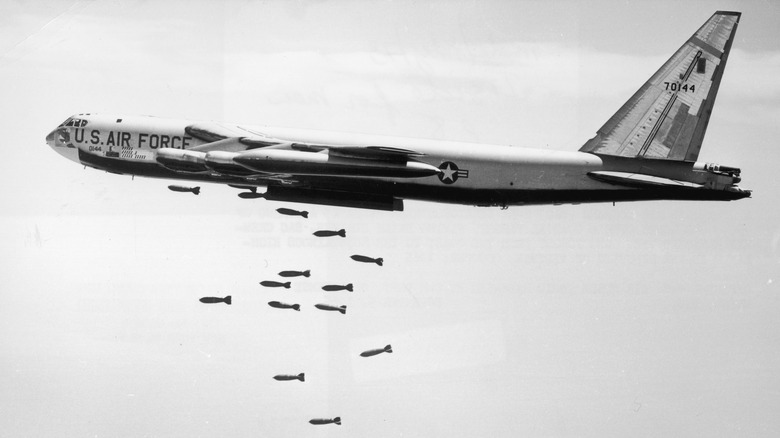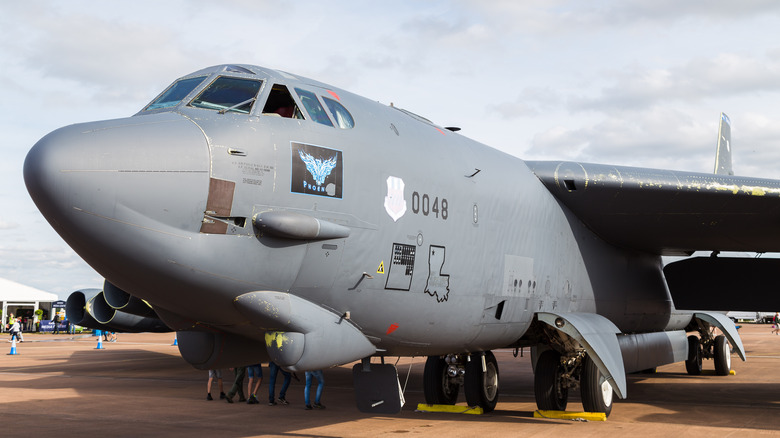Here's Why The U.S. Is Still Flying The B-52 Stratofortress
World War II was the most devastating conflict in human history, and while it was horrific, it also spurred many innovations and inventions. This included the development of long-range strategic bombers like the B-17 and B-24, but development didn't stop at the end of the war. The United States continued working on its strategic bomber force, and by 1955, it introduced the iconic B-52 Stratofortress, now known as the Big Ugly Fat Fella (BUFF), which upgraded from the old propeller-based aircraft to using jets.
The B-52 was a game-changer in terms of the U.S.'s strategic bomber force, and despite its first flight occurring in 1952, the U.S. operates them more than 70 years later. All told, Boeing produced 744 B-52s, with the first entering active service in 1955. Since then, the aircraft has been upgraded numerous times, bringing it up to speed with modern enhancements, and only 76 B-52s remain in operation.
Because of this, the U.S. continues flying its fleet of B-52s, and there's no plan to stop using them anytime soon. The U.S.'s current plan is to operate the aircraft until sometime in the 2060s, which could make it the longest-serving combat aircraft in history with nearly a century of continued active service. This is due to a number of factors, but primarily, the B-52 is reliable, requires a small crew, can carry a variety of ordnance, and is relatively inexpensive.
What are the B-52's capabilities?
The B-52 is a strategic bomber and has plenty of stats to back that up. It can carry a payload of 70,000 lbs. while flying up to Mach 0.84 (650 mph) with an unrefueled combat range of 8,800 miles. It can fly as high as 50,000 feet and can carry a variety of ordnance. These include everything from bombs and mines to air-launched cruise missiles in later designs. Additionally, the B-52 can carry nuclear ordnance, making it part of the United States' nuclear triad.
A B-52H Red Gremlin II can carry six nuclear-armed AGM-86B air-launched cruise missiles (ALCM) under each wing. These 12 missiles are incredibly deadly weapons, each of which houses a W80-1 nuclear warhead capable of unleashing five-150 kiloton detonations. Fortunately, these have never been fired in anger and remain a part of the U.S.'s strategic nuclear policy.
The B-52 was initially designed to carry atomic bombs to the Soviet Union during the Cold War, and it continues to operate in this capacity. Each B-52 model featured a variety of defensive capabilities, including rear quad .50 caliber machine guns, an M62 20mm rotary cannon, and a variety of defensive rockets. The B-52 supported operations around the world since its introduction, including flying in support of the Vietnam War, the 1991 Gulf War, NATO operations in the Balkans, and numerous conflicts in the 21st century.
Why the U.S. continues to fly its fleet of B-52s
Since its introduction in the 1950s, the U.S. has developed several strategic bombers, many of which are technologically superior to the older aircraft. This is true despite the many upgrades the B-52 has undergone. Notably, the B-52 lacks stealth capabilities, putting it far behind the B-2 Spirit and the forthcoming B-21 Raider, which is expected to enter service in the mid-2020s. When this happens, it could replace the B-52.
Still, while the U.S. continues developing its long-range strategic bomber force, the nation continues operating the B-52 and plans to do so for decades. One of the main reasons for this is the aircraft's proven track history in a number of conflicts. While it was designed to drop nukes, it's demonstrated numerous times that it can drop conventional ordnance just as well, having supported missions against ISIS in Syria and Iraq in approximately 1,800 sorties.
Additionally, relatively few B-52s have been shot down, and it's versatile. In addition to operating as a strategic nuclear deterrent and conventional bomber, B-52s fill numerous roles, including close-air support, offensive counter-air, maritime operations, and air interdiction. It can also gather intelligence, specifically in ocean surveillance, to support the U.S. Navy. Whatever the role, the B-52 can likely fill it, and cost is a factor. The U.S. spent approximately $84 million on each aircraft, while more modern counterparts like the B-2 cost $1.157 billion, making the B-52 a more affordable option the U.S. cannot overlook.


